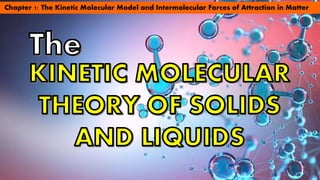Lesson 1_Kinetic Molecular Theory of Solids and Liquids.pptx
•Download as PPTX, PDF•
0 likes•970 views
The document discusses the kinetic molecular theory and how it can be used to explain the properties of liquids and solids. It defines the kinetic molecular theory and its key postulates, including that matter is made of particles in constant motion, kinetic energy increases with temperature, and the amount of space between particles depends on the state of matter. It then describes the properties of solids, liquids, and gases based on this theory, noting that solids have the greatest intermolecular forces and particles vibrate in fixed positions, while liquids have less forces but particles can slide past one another.
Report
Share
Report
Share

Recommended
Recommended
This power point work describe about polar and nonn polar compounds and how to find it very easily and it also explain dipole moment and its calculation...this includes some workout problems Polar and non polar compounds and dipole moment - PPT

Polar and non polar compounds and dipole moment - PPTSri Ramakrishna Mission Vidyalaya College of Arts and Science,Coimbatore-20.
More Related Content
What's hot
This power point work describe about polar and nonn polar compounds and how to find it very easily and it also explain dipole moment and its calculation...this includes some workout problems Polar and non polar compounds and dipole moment - PPT

Polar and non polar compounds and dipole moment - PPTSri Ramakrishna Mission Vidyalaya College of Arts and Science,Coimbatore-20.
What's hot (20)
6-EFFECTS-OF-INTERMOLECULAR-Forces-on-Properties-of-Substances.pptx

6-EFFECTS-OF-INTERMOLECULAR-Forces-on-Properties-of-Substances.pptx
Lesson 1 Kinetic Molecular Model of Liquid and Solids.pptx

Lesson 1 Kinetic Molecular Model of Liquid and Solids.pptx
Polar and non polar compounds and dipole moment - PPT

Polar and non polar compounds and dipole moment - PPT
Similar to Lesson 1_Kinetic Molecular Theory of Solids and Liquids.pptx
Similar to Lesson 1_Kinetic Molecular Theory of Solids and Liquids.pptx (20)
More from KimberlyAnnePagdanga1
More from KimberlyAnnePagdanga1 (20)
M3_Digestion Interaction with other Organ Systems.pptx

M3_Digestion Interaction with other Organ Systems.pptx
M1_Lesson 1_How greeks know that earth is spherical.pptx

M1_Lesson 1_How greeks know that earth is spherical.pptx
Recently uploaded
Recently uploaded (20)
GBSN - Microbiology (Lab 1) Microbiology Lab Safety Procedures

GBSN - Microbiology (Lab 1) Microbiology Lab Safety Procedures
insect taxonomy importance systematics and classification

insect taxonomy importance systematics and classification
The importance of continents, oceans and plate tectonics for the evolution of...

The importance of continents, oceans and plate tectonics for the evolution of...
Gliese 12 b: A Temperate Earth-sized Planet at 12 pc Ideal for Atmospheric Tr...

Gliese 12 b: A Temperate Earth-sized Planet at 12 pc Ideal for Atmospheric Tr...
A Giant Impact Origin for the First Subduction on Earth

A Giant Impact Origin for the First Subduction on Earth
Jet reorientation in central galaxies of clusters and groups: insights from V...

Jet reorientation in central galaxies of clusters and groups: insights from V...
Extensive Pollution of Uranus and Neptune’s Atmospheres by Upsweep of Icy Mat...

Extensive Pollution of Uranus and Neptune’s Atmospheres by Upsweep of Icy Mat...
Gliese 12 b, a temperate Earth-sized planet at 12 parsecs discovered with TES...

Gliese 12 b, a temperate Earth-sized planet at 12 parsecs discovered with TES...
Detectability of Solar Panels as a Technosignature

Detectability of Solar Panels as a Technosignature
Topography and sediments of the floor of the Bay of Bengal

Topography and sediments of the floor of the Bay of Bengal
Mammalian Pineal Body Structure and Also Functions

Mammalian Pineal Body Structure and Also Functions
Lesson 1_Kinetic Molecular Theory of Solids and Liquids.pptx
- 1. Chapter 1: The Kinetic Molecular Model and Intermolecular Forces of Attraction in Matter
- 4. TEMPERATURE
- 6. SOLID
- 7. LIQUID
- 8. SPEED
- 9. Use the kinetic molecular model to explain properties of liquids and solids (STEM_GC11IMFIIIa-c-99) Learning Competency
- 10. Why do solids and liquids behave differently?
- 11. Directions: Watch the short video carefully and answer the questions that follow.
- 13. Questions: 1. What happen after dropping the food color into water? Why did this happen? 2. How can you compare the rate of diffusion in the glasses? What is the reason for this difference? 3. How can you relate the kinetic molecular theory the experiment?
- 15. What is Kinetic Molecular Theory? The kinetic-molecular theory is a theory that explains the states of matter and is based on the idea that matter is composed of tiny particles that are always in motion.
- 16. 1. Matter is made of particles that are constantly in motion. This energy in motion is called kinetic energy. 2. The amount of kinetic energy in a substance is related to its temperature. Increased temperature means greater speed. 3. There is space between particles. The amount of space in between particles is related to the substance's state of matter. 4. Phase changes happen when the temperature of the substance changes sufficiently. 5. There are attractive forces in between particles called intermolecular forces. The strength of these forces increase as particles get closer together. Postulates of Kinetic Molecular Theory
- 17. o Definite shape and volume. o Difficult to compress. o Particles of solids are tightly packed, vibrating about a fixed position. o Has the greatest force of attraction between particles.
- 18. o Definite volume , No definite shape o Hard to compress o Particles slide past each other o Forces of attraction between particles still high, next to solids
- 19. o No definite shape or volume o Expands to fill container o Little attraction between particles “Vapor” = a gaseous state of something that is normally liquid (Ex: water vapor)
- 20. Directions: Based on the picture, identify what state of matter is being represented. Write a brief description based on the arrangement of their particles and give three examples for each state.
- 21. Directions: Compare the properties of solids and liquids by completing the table based on their kinetic molecular model